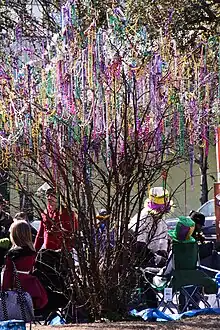
Mardi Gras throws are strings of beads, doubloons, cups, or other trinkets passed out or thrown from the floats in the New Orleans Mardi Gras, the Mobile Mardi Gras and parades all throughout the Gulf Coast of the United States, to spectators lining the streets. The "gaudy plastic jewelry, toys, and other mementos [are] tossed to the crowds from parading floats". The 'throws', consist of necklaces of plastic beads, coins called doubloons, which are stamped with krewes' logos, parade themes and the year, plus an array of plastic cups and toys such as Frisbees, figurines and LED trinkets.[1] The plastic cups that are used as throws are sometimes referred to as New Orleans dinnerware.[2]
Beads used on Mardi Gras (known as Shrove Tuesday in some regions) are purple, green, and gold, with these three colors containing the Christian symbolism of justice, faith, and power, respectively.[3][4] Traditionally, Mardi Gras beads were manufactured in Japan and Czech Republic, although many are now imported from mainland China.[5] As Fat Tuesday concludes the period of Carnival (Shrovetide), Mardi Gras beads are taken off oneself on the following day, Ash Wednesday, which begins the penitential season of Lent.[6] As such, one of the "solemn practices of Ash Wednesday is to pack all the beads acquired during the parade season into bags and boxes and take them to the attic".[6]
The tradition of throwing Mardi Gras throws to spectators during the parade started with the second procession of the Twelfth Night Revelers in the early 1870s, with an individual dressed as Santa Claus passing out gifts to spectators as he passed by. The tradition was then expanded and continued by the Krewe of Rex who began to throw glass beads to spectators in the early 20th century. [7]
Spectators have traditionally shouted to the krewe members, "Throw me something, mister!", a phrase that is iconic in New Orleans' Mardi Gras street argot. Some women expose their breasts to invite throws in the French Quarter, although this is not required or even classed as a true Mardi Gras tradition, it is however quite common during French Quarter parades.[8][9]
Some krewes have specialty throws: for example, the Zulu Social Aid & Pleasure Club hand-painted coconut[10] or the Krewe of Muses hand-decorated glitter shoes.
References
- ↑ Patterson, Alice (2020-01-24). "Creating An Amazing Mardi Gras Event". Oddle Entertainment Agency. Retrieved 2020-01-26.
- ↑ "Mardi Gras New Orleans". MardiGrasNewOrleans.com. Retrieved 2012-06-18.
- ↑ Wilkie, Laurie A (16 June 2016). Strung Out on Archaeology: An Introduction to Archaeological Research. Routledge. p. 253. ISBN 9781315419527.
- ↑ Murray, Julie (1 January 2014). Mardi Gras. ABDO Publishing Company. p. 16. ISBN 9781629680705.
- ↑ Geary, Theresa Flores (2008). The Illustrated Bead Bible: Terms, Tips & Techniques. Sterling Publishing Company, Inc. p. 188. ISBN 9781402723537.
- 1 2 Higgins, Earl J. (2007). The Joy of Y'at Catholicism. Pelican Publishing. p. 122. ISBN 9781455606856.
- ↑ "Throw me somethin' mister! The history behind New Orleans Mardi Gras throws | The Historic New Orleans Collection". www.hnoc.org. Retrieved 2022-04-19.
- ↑ Shrum, W. and J. Kilburn. Ritual Disrobement at Mardi Gras: Ceremonial Exchange and Moral Order. Social Forces, Vol. 75, No. 2. (December 1996), pp. 423–458.
- ↑ Mardi Gras History and Traditions Archived 2010-02-08 at the Wayback Machine mardigrasneworleans.com
- ↑ New Orleans Mardi Gras. "Zulu Mardi Gras Coconut"